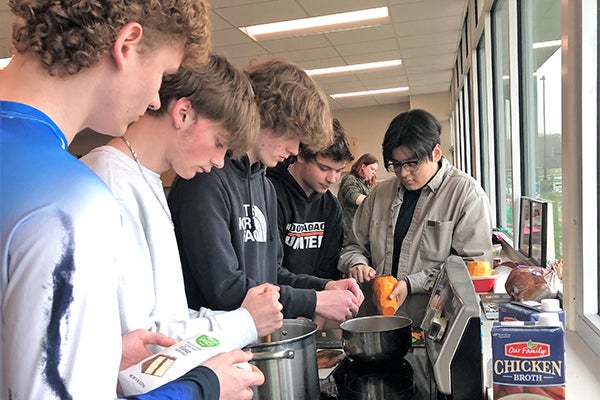Inspired by Pokagon, DUHS students make Three Sisters soup
Published 1:03 pm Tuesday, April 5, 2022
|
Getting your Trinity Audio player ready...
|
DOWAGIAC — For many indigenous tribes in North America, three crops – corn, beans and squash – were considered the foundation of sustenance for their ability to work together, as well as their ability to sustain the people.
Together, the crops are known as the “Three Sisters,” and modern tribes – including the local Pokagon Band of Potawatomi – continue to celebrate the trio of vegetables as staples in the diet.
Students in Andy Kruger’s culinary classes at Dowagiac Union High School worked together last Thursday to honor the area’s indigenous roots by preparing a traditional Three Sisters soup using a 100-plus-year-old family recipe from one of Kruger’s students.
“About a month ago we did a Potawatomi Pokagon Band research project where students researched questions about their culture and language,” Kruger said. “I found out that two of my students were Potawatomi. … The other day our Potawatomi students decided to make Three Sisters soup.”
Student Adrien Barger, who is Potawatomi, provided the family recipe which had been passed down from his great-grandmother. Anthony Hyatt, another student in the culinary class, also has Potawatomi heritage, according to Kruger.
“Those guys took the lead on this,” said Kruger, referring to Barger and Hyatt. “I didn’t even have to suggest it. They came in and wanted to make the soup.”
According to the Michigan State University Extension, the vegetables work interdependently when grown together as companion crops. The corn stalk provides support for the beans to grow upward, while the squash spreads out, providing protection and support for the roots of the plants. The trio of plants also enriches the soil, attracts pollinators and deters pests, according to the Farmer’s Almanac website.
There is also a popular Three Sisters legend that explains how the crops came to be. According to Oneida Indian Nation, the Iroquois legend tells the story of three sisters who lived in a field.
“The youngest was so small she could not yet walk; she crawled along the ground, dressed in green,” the story said. “The middle sister wore a bright yellow dress and darted back and forth across the field. The eldest sister stood tall and straight, and her body bent with the wind. She had long yellow hair and wore a green shawl. The three sisters loved one another very much and could not imagine living without the others.”
Eventually, the sisters came upon a little Indian boy. After growing fond of the boy, the three sisters followed the boy home as winter drew near, and ended up proving useful to the boy and his family.
“The youngest, now all grown up, kept the dinner pot full, while the second sister, still in her yellow dress, dried herself on the shelf so she could fill the dinner pot later in the winter,” reads the story. “The eldest sister was so pleased to be with her sisters again and so impressed with the help they gave the boy that she too began drying herself so the family would have meals to use as the winter went on. … And from that day to this, the three sisters were never separated again.”
For Kruger, learning about this tradition was a gratifying experience.
“It’s important because these were the original people here,” said Kruger, of the Pokagon. “I think the tribal elders will really like that the young people are taking interest in the culture.”







